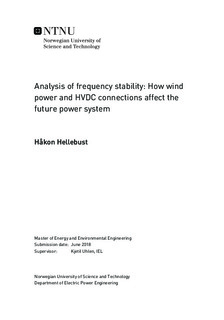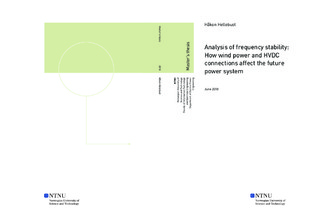| dc.description.abstract | Many modern power systems are facing massive changes. Two of the main development trends are more interconnections between neighboring power systems and significant growth in installed capacity of wind power and other decoupled production. These technologies might affect the levels of inertia in the power system, and thus possibly reduce the frequency stability.
To always have satisfactory system stability is vital for a successful operation of the power grid, now and in the future.
The recent development of in the fields of controllers and power electronics enable HVDC links and wind turbines to contribute to the frequency stability.
This thesis aimed to illuminate the implications on frequency stability from the development trends of more wind power and HVDC connections in power system. Would it lead to less system inertia? Would the system become more or less stable in the future? What can be done to maintain satisfactory system stability?
An extensive literature study was conducted, with the main findings presented in this report.
A set of frequency response indicators were introduced to facilitate examination of the frequency responses to disturbances.
Simulations were conducted to examine the contribution from HVDC and wind power both without measures to improve the frequency response and with additional controllers providing synthetic inertia. The primary emphasis has been on the Nordic system which was the base for the simulation model. Simulations have also been conducted in a smaller and more transparent model.
Four main scenarios have been investigated: Situations with very high and low inertia in the present system (2017) and the future (2030). Five disconnection events and one short-circuiting have been studied for all the scenarios.
The events along with the scenarios have been extremes, meaning that they are representing the grid under extraordinary conditions.
For the future scenarios, additional controllers have in turn been enabled for wind power production and HVDC connectors to explore their possible contribution the frequency support.
The major parts of the simulations were conducted in an extensive Nordic simulation model. The results indicated that the future grid would experience far less inertia during operation hours where the inertia levels already a low. Most frequency response indicators suggested that the frequency response was deteriorated in the future grid when no measures of mitigation had been implemented.
At some hours, the disturbances induced more than 30% higher frequency deviations in the future grid. The expanding technologies of wind power and HVDC connections are replacing conventional generation, reducing system inertia and other favorable properties associated with such production. During scenarios with very high load (winter at peak hours), the results showed that system inertia would remain at a stable high level.
Two conceptual controllers were developed to allow the HVDC connections and wind turbines to provide synthetic inertia to the grid. This proved to improve the frequency response significantly. These results suggest that the expanding technologies can successfully offer frequency support to stabilize the power grid.
Voltages and power flows have been briefly examined to explore the most critical operating conditions. Significant voltage dips and power flow changes, both with oscillations, were detected. Some voltages were dipping more than 10% of nominal value. However, the oscillations died quickly and the system remained stable for all disturbances in all scenarios.
Several sources of error could have affected the validity of the results.
The controllers developed were conceptual, and may not induce a response similar to complex and optimized controller developed by professionals.
Modeling the future is also associated with considerable uncertainties, as the input for the future never can be known precisely.
However, the results are strengthened by simulating in two models (one complex and one simple), and by corresponding to existing research and expectations.
The topic of interest is complicated, and further studies to illuminate how wind power and HVDC connections affect the power system is necessary. Some of the most interesting future studies may include improving the controllers, testing and tuning the model to a real-world system, and examining the effects on the HVDC and wind components when they are providing synthetic inertia. | |

